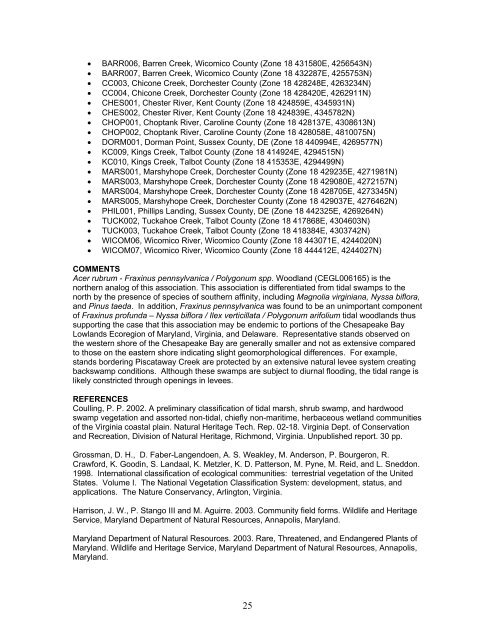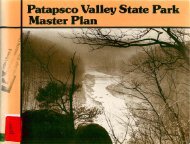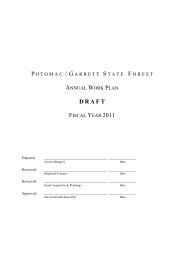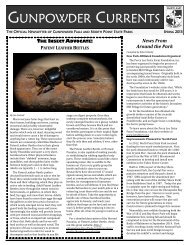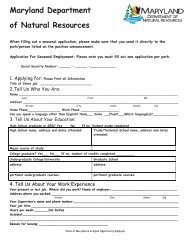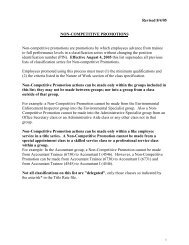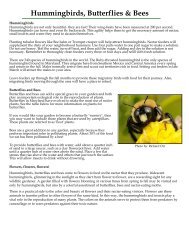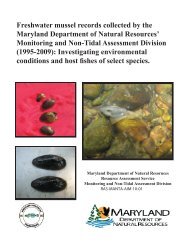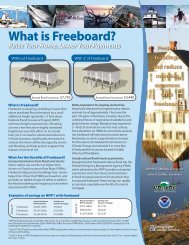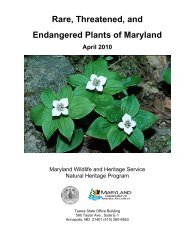tidal hardwood swamps - Maryland Department of Natural Resources
tidal hardwood swamps - Maryland Department of Natural Resources
tidal hardwood swamps - Maryland Department of Natural Resources
Create successful ePaper yourself
Turn your PDF publications into a flip-book with our unique Google optimized e-Paper software.
• BARR006, Barren Creek, Wicomico County (Zone 18 431580E, 4256543N)<br />
• BARR007, Barren Creek, Wicomico County (Zone 18 432287E, 4255753N)<br />
• CC003, Chicone Creek, Dorchester County (Zone 18 428248E, 4263234N)<br />
• CC004, Chicone Creek, Dorchester County (Zone 18 428420E, 4262911N)<br />
• CHES001, Chester River, Kent County (Zone 18 424859E, 4345931N)<br />
• CHES002, Chester River, Kent County (Zone 18 424839E, 4345782N)<br />
• CHOP001, Choptank River, Caroline County (Zone 18 428137E, 4308613N)<br />
• CHOP002, Choptank River, Caroline County (Zone 18 428058E, 4810075N)<br />
• DORM001, Dorman Point, Sussex County, DE (Zone 18 440994E, 4269577N)<br />
• KC009, Kings Creek, Talbot County (Zone 18 414924E, 4294515N)<br />
• KC010, Kings Creek, Talbot County (Zone 18 415353E, 4294499N)<br />
• MARS001, Marshyhope Creek, Dorchester County (Zone 18 429235E, 4271981N)<br />
• MARS003, Marshyhope Creek, Dorchester County (Zone 18 429080E, 4272157N)<br />
• MARS004, Marshyhope Creek, Dorchester County (Zone 18 428705E, 4273345N)<br />
• MARS005, Marshyhope Creek, Dorchester County (Zone 18 429037E, 4276462N)<br />
• PHIL001, Phillips Landing, Sussex County, DE (Zone 18 442325E, 4269264N)<br />
• TUCK002, Tuckahoe Creek, Talbot County (Zone 18 417868E, 4304603N)<br />
• TUCK003, Tuckahoe Creek, Talbot County (Zone 18 418384E, 4303742N)<br />
• WICOM06, Wicomico River, Wicomico County (Zone 18 443071E, 4244020N)<br />
• WICOM07, Wicomico River, Wicomico County (Zone 18 444412E, 4244027N)<br />
COMMENTS<br />
Acer rubrum - Fraxinus pennsylvanica / Polygonum spp. Woodland (CEGL006165) is the<br />
northern analog <strong>of</strong> this association. This association is differentiated from <strong>tidal</strong> <strong>swamps</strong> to the<br />
north by the presence <strong>of</strong> species <strong>of</strong> southern affinity, including Magnolia virginiana, Nyssa biflora,<br />
and Pinus taeda. In addition, Fraxinus pennsylvanica was found to be an unimportant component<br />
<strong>of</strong> Fraxinus pr<strong>of</strong>unda – Nyssa biflora / Ilex verticillata / Polygonum arifolium <strong>tidal</strong> woodlands thus<br />
supporting the case that this association may be endemic to portions <strong>of</strong> the Chesapeake Bay<br />
Lowlands Ecoregion <strong>of</strong> <strong>Maryland</strong>, Virginia, and Delaware. Representative stands observed on<br />
the western shore <strong>of</strong> the Chesapeake Bay are generally smaller and not as extensive compared<br />
to those on the eastern shore indicating slight geomorphological differences. For example,<br />
stands bordering Piscataway Creek are protected by an extensive natural levee system creating<br />
backswamp conditions. Although these <strong>swamps</strong> are subject to diurnal flooding, the <strong>tidal</strong> range is<br />
likely constricted through openings in levees.<br />
REFERENCES<br />
Coulling, P. P. 2002. A preliminary classification <strong>of</strong> <strong>tidal</strong> marsh, shrub swamp, and <strong>hardwood</strong><br />
swamp vegetation and assorted non-<strong>tidal</strong>, chiefly non-maritime, herbaceous wetland communities<br />
<strong>of</strong> the Virginia coastal plain. <strong>Natural</strong> Heritage Tech. Rep. 02-18. Virginia Dept. <strong>of</strong> Conservation<br />
and Recreation, Division <strong>of</strong> <strong>Natural</strong> Heritage, Richmond, Virginia. Unpublished report. 30 pp.<br />
Grossman, D. H., D. Faber-Langendoen, A. S. Weakley, M. Anderson, P. Bourgeron, R.<br />
Crawford, K. Goodin, S. Landaal, K. Metzler, K. D. Patterson, M. Pyne, M. Reid, and L. Sneddon.<br />
1998. International classification <strong>of</strong> ecological communities: terrestrial vegetation <strong>of</strong> the United<br />
States. Volume I. The National Vegetation Classification System: development, status, and<br />
applications. The Nature Conservancy, Arlington, Virginia.<br />
Harrison, J. W., P. Stango III and M. Aguirre. 2003. Community field forms. Wildlife and Heritage<br />
Service, <strong>Maryland</strong> <strong>Department</strong> <strong>of</strong> <strong>Natural</strong> <strong>Resources</strong>, Annapolis, <strong>Maryland</strong>.<br />
<strong>Maryland</strong> <strong>Department</strong> <strong>of</strong> <strong>Natural</strong> <strong>Resources</strong>. 2003. Rare, Threatened, and Endangered Plants <strong>of</strong><br />
<strong>Maryland</strong>. Wildlife and Heritage Service, <strong>Maryland</strong> <strong>Department</strong> <strong>of</strong> <strong>Natural</strong> <strong>Resources</strong>, Annapolis,<br />
<strong>Maryland</strong>.<br />
25


